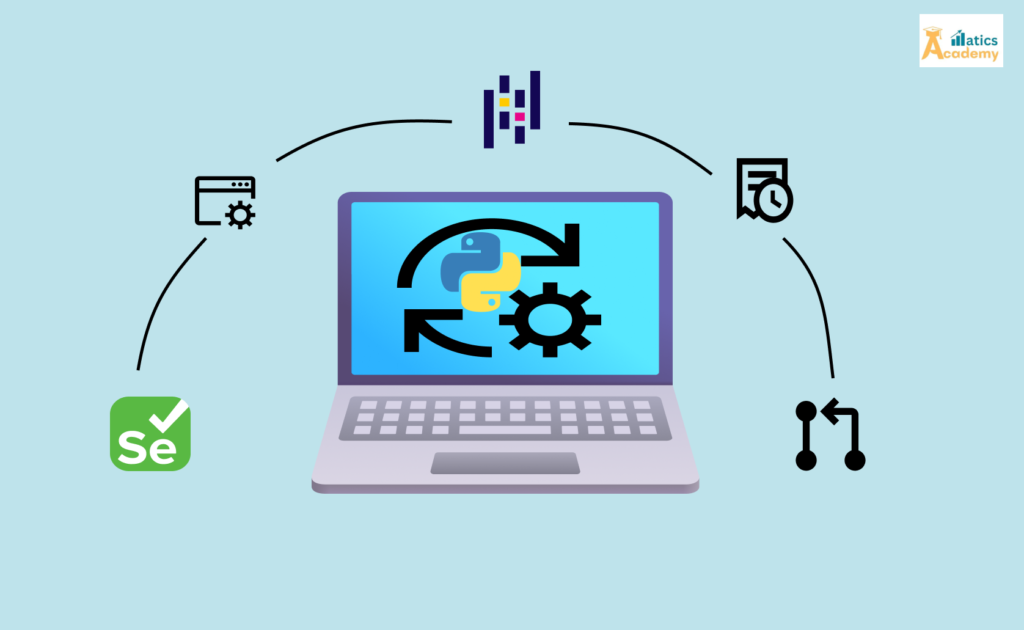Python is widely regarded as one of the best programming Language for Automation, thanks to its simplicity, flexibility, and extensive libraries. Whether you’re automating repetitive tasks, managing systems, or integrating with APIs, Python provides powerful tools to streamline workflows. This guide covers the essentials of Python automation, libraries, examples, best practices, advantages & disadvantages, and common interview questions.
Why Use Python for Automation?
- Ease of Use: Python’s simple syntax makes automation accessible for beginners and professionals alike.
- Versatility: Automate tasks in file handling, web scraping, testing, and beyond.
- Extensive Libraries: A rich ecosystem of libraries accelerates automation development.
Popular use cases include web scraping, file and folder automation, task scheduling, and data processing.

Key Libraries for Automation
- Selenium
For browser automation and web testing. - Beautiful Soup
For web scraping and extracting HTML data. - PyAutoGUI
For GUI automation, mouse, and keyboard control. - Pandas
For data manipulation and processing automation. - Schedule
For scheduling and automating tasks. - Requests
For automating HTTP requests and APIs.
Steps to Automation Task in Python
- Identify the Task
- Understand the repetitive task you want to automate and break it down into steps.
- Choose the Right Library
- Select a library or framework suited for the automation. For example, use Selenium for web automation or Pandas for data processing.
- Write the Script
- Write a Python script to automate the steps.
- Test the Automation
- Run your script and debug any issues.
- Schedule the Script (Optional)
- Use task schedulers like Cron (Linux) or Task Scheduler (Windows) to run the script automatically at defined intervals.
Python Automation Examples
1. Automating File Management
import os
import shutil
# Move files based on extension
# Use raw strings for paths to avoid potential issues with escape characters
source_dir = r'C:/Users/YourName/Downloads'
destination_dir = r'C:/Users/YourName/Documents'
# Verify that the source directory exists
if not os.path.exists(source_dir):
print(f"Error: Source directory '{source_dir}' does not exist.")
else:
for file in os.listdir(source_dir):
if file.endswith('.pdf'):
shutil.move(os.path.join(source_dir, file), os.path.join(destination_dir, file))2.Web Scraping with Beautiful Soup
from bs4 import BeautifulSoup
import requests
# Fetch webpage
url = "https://example.com"
response = requests.get(url)
soup = BeautifulSoup(response.text, 'html.parser')
# Extract data
titles = soup.find_all('h2')
for title in titles:
print(title.text)
3.Browser Automation with Selenium
from selenium import webdriver
# Set up the browser
driver = webdriver.Chrome()
driver.get("https://google.com")
# Automate search
search_box = driver.find_element('name', 'q')
search_box.send_keys('Python automation')
search_box.submit()
# Close browser
driver.quit()
4.Automating Email Sending
import smtplib
# Email credentials
sender = "your_email@example.com"
receiver = "receiver_email@example.com"
password = "your_password"
# Set up SMTP
server = smtplib.SMTP('smtp.gmail.com', 587)
server.starttls()
server.login(sender, password)
# Send email
message = "Subject: Test Email\n\nHello, this is an automated email."
server.sendmail(sender, receiver, message)
server.quit()
5.Task Scheduling
import schedule
import time
# Define a task
def job():
print("Automated Task Running")
# Schedule the task
schedule.every(10).seconds.do(job)
while True:
schedule.run_pending()
time.sleep(1)
Advantages of Python Automation
- Time-Saving: Reduces manual effort by automating repetitive tasks.
- Cost-Effective: Minimal development costs compared to other languages.
- Scalability: Suitable for small scripts and enterprise-level automation.
- Extensibility: Integrates with APIs, databases, and third-party tools.
Disadvantages of Python Automation
- Initial Learning Curve: Beginners might struggle with libraries and debugging.
- Resource Usage: Complex automation can consume more system resources.
- Maintenance: Automated scripts require regular updates for changes in dependencies or APIs.
Conclusion
Automation in Python is a game-changer for improving efficiency and productivity. By leveraging Python’s rich ecosystem of libraries and tools, you can simplify workflows and focus on more strategic tasks. Follow this guide to master Python automation and take your skills to the next level.
Interview Questions
1. What tasks can be Used for Python Automation?
Company: Google
Answer: Python can automate tasks like web scraping, email notifications, file management, data analysis, and testing.
2. How do you ensure the reliability of automation scripts?
Company: Microsoft
Answer:
- Use error handling and logging.
- Test scripts with different inputs.
- Monitor automation regularly for failures.
3. What are the limitations of Selenium in automation?
Company: Meta (Facebook)
Answer:
- Limited to web browsers.
- Requires browser drivers.
- Challenging to handle dynamic websites with heavy JavaScript.
4. How do you automate repetitive tasks on a schedule in Python?
Company: Amazon
Answer: Use the schedule library for Python or external tools like Cron on Linux and Task Scheduler on Windows.
5. What is the difference between automation with Beautiful Soup and Selenium In Python Automation?
Company: Netflix
Answer:
- Beautiful Soup is used for static web scraping.
- Selenium is used for dynamic websites requiring interaction.
QUIZZES
Automation Tutorial Quiz
Question
Your answer:
Correct answer:
Your Answers
